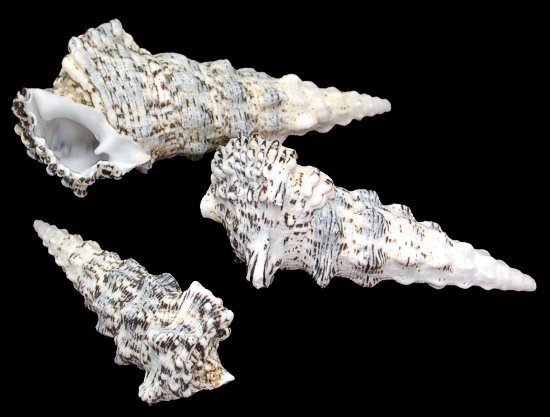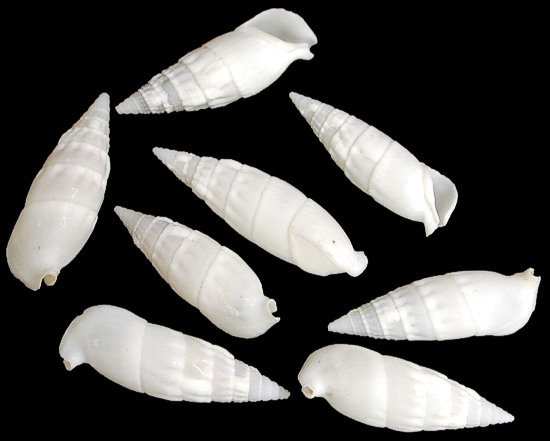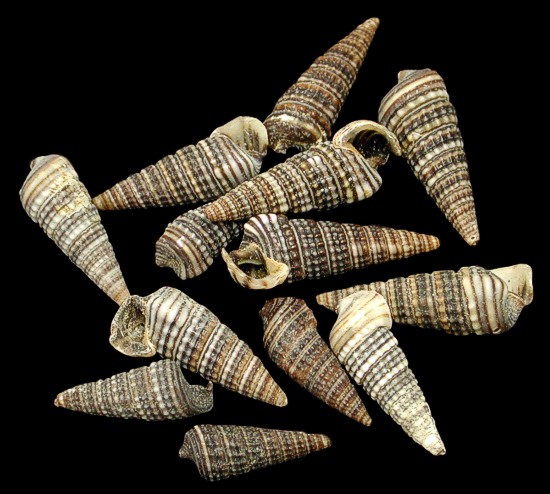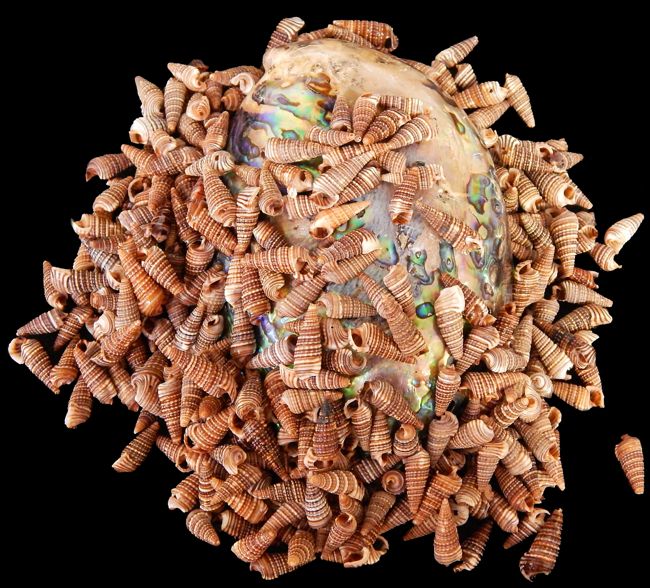As the site is updated, each listing includes the shipping cost. Some listings which I have not updated still give you calculated shipping costs based on weight and size of package. (In the sections I have updated) If you select several different listings, we will consolidate your order and charge you the actual cost of the entire package. The shipping over charge will be refunded to you, when your order is shipped.
Cerithiums

Cerithium caeruleum common name Knobby Cerithium
Q1-9
Six hand-selected Cerithium caeruleum (Knobby Cerithium) shells, measuring between 2 and 3.5 inches. ..... $7.65
Cerithium Caeruleum
Cerithium caeruleum, the Cerith sand snail, is a species of sea snail, a marine gastropod mollusk in the family Cerithiidae. Cerithium caeruleum, also be called Cerithium caeruleum G.B. Sowerby II, 1855 generally can be found in large populations on intertidal rocky shores and are covered by a thin layer of sediments. They have large and solid shells, and their radula ribbon is robust long and about one-fifth of the shell length. This species lives in the planktonic stage lasts from 90 to 120 days and has a seven-year life history. This common intertidal species is confined to east Africa, Madagascar, and the Arabian Peninsula and is unlikely to be confused with any other Cerithium species. It is distinguished by its squat, knobby shape; and as indicated by its name, caeruleum, a grayish blue color with spiral rows of black tubercles.
radula a structure of tiny teeth used for scraping food particles off a surface and drawing them into the mouth.
planktonic the small or microscopic organisms that drift or swim weakly in a body of water.This species is widespread in the tropical Indo-Pacific (Red Sea, Kenya, Madagascar, Mozambique, Tanzania and Western India). The shell of Cerithium caeruleum is large, solid, stocky, knobby, reaching 1 2/3 length to 3/4 inch width, and comprising 8-12 angulate, nodulose whorls. Early teleoconch whorls sculptured with 2 or 3 spiral cords, numerous fine spiral lirae, and weak axial ribs. Adult teleoconch whorls angulate, sculptured with numerous spiral lirae separated by incised spiral lines, fine, colabral axial lines, and with two dominant spiral cords— small, beaded, belt-like, subsutural cord, and very large, nodulose, median cord. A median spiral cord of penultimate whorl has 8-12 large nodes and a wide sutural ramp. Nodes are sometimes spiny and axially drawn out. The suture is slightly impressed. Body whorl is large, wide, elongate, with weak siphonal constriction. Body whorl microsculpture same as on adult whorls, but with 4 or 5 major nodulose, beaded, or nearly smooth, spiral cords. The aperture is ovate, a little more than one-third the shell length. Columella concave with moderate thick callus. Anterior siphonal canal is short and strongly reflected left of shell axis. Anal canal is deep and folded into weak inner denticles. Shell color is grayish-blue flecked with white; nodes black, early whorls white.
teleoconch The portion of the shell formed immediately after the larval stage of the life cycle of the organism
whorl(a circular pattern of lines, with the smallest circle in the middle, surrounded by other circles,
nodulosea small rounded lump of matter distinct from its surroundings
Columellaa small column
siphonal to draw liquid by means of a siphon
denticles any small tooth-like or bristle-like structure
The egg capsules of C. caeruleum each have a diameter of about 6 inches, and there is an incubation period of 4–5 days prior to hatching. Reproductive studies and growth statistics calculated by Ayal and Safriel provide evidence that this species lives from 90 to 120 days in the plankton and has a seven-year life expectancy
Foraging fish are the major predators of juvenile Cerithium caeruleum. Taylor and Reid found the murex snails to be the major predator of adult populations. Adult prey were attacked through the aperture, while smaller individuals were usually drilled through the spire.
These species dwell in intertidal rocky shelfs with a thin covering of sediment. They live in the upper intertidal zone on beach stones. The Cerithium caeruleum survive in a wide range of environmental gradients.
These species live along the continental margins of the western Indian Ocean where it is found as far south as Natal and Madagascar. They also are found on Aldabra Atoll and in the Red Sea and Persian Gulf, extending eastward to the coasts of Pakistan and western India. They feed on algae and detritus (waste or debris of any kind).
Scientific classification
Domain: Eukaryota
Kingdom: Animalia
Phylum: Mollusca
Class: Gastropoda
Subclass: Caenogastropoda
Family: Cerithiidae
Genus: Cerithium
Species: C. caeruleum
Binomial name: Cerithium caeruleum
G.B. Sowerby II, 1855
(REF:"Cerithium caeruleum G. B. Sowerby II, 1855". World Register of Marine Species) (REF: Houbrick, Richard S. (1992). "Monograph of the genus Cerithium Bruguiere in the Indo-Pacific (Cerithiidae: Prosobranchia)". Smithsonian Contributions to Zoology) (REF: Ayal, Y.; Safriel, U. N. (1982). "Role of competition and predation in determining habitat occupancy of Cerithiidae (Gastropoda: Prosobranchia) on the rocky, intertidal, Red Sea coasts of Sinai". Marine Biology. 70) (REF: "Cerithium caeruleum". Gastropods.com.) (REF: "Cerithium caeruleum G.B. Sowerby II, 1855". Global Biodiversity Information Facility.)

White Cerithium Shell
Z1-10
One quarter pound of White Cerithium Shells, shells measuring 1.5 to 2 inches ...... $5.99
CerithiidaeCerithiidae common name the cerithiids or ceriths, is a large family of medium-sized marine gastropods in the clade Sorbeoconcha.
Ceriths are found worldwide on sandy bottoms, reef flats or coral reef rock covered with sand and algae. They live in warm or temperate waters; but mostly in tropical areas. A few have been found along the European coastline and a few species along the American coast. Some have been found in estuarine areas of mangrove forests close to the sea. Only a few species of the subfamily Bittiinae are found in deep water.
Ceriths are herbivores and detritivores that graze the sea bed.
herbivores an animal that feeds on plants
detritivores waste or debris of any kind
Their slender shell is elongated with a pointed spire. They vary in size from less than a 1/4 inch (Bittium alternatum) to 6 inches (Cerithium nodulosum). The smallest shells are found in the subfamily Bittiinae.
spire the highest point
The many whorls have radial sculpture with axial ridges and nodules. The aperture shows at its base a vague curve or a distinct siphonal canal. The aperture is closed off by a thin oval brown operculum that is corneous and paucispiral. The palatal wall of the aperture is somewhat enlarged and often shows a varix.
whorls a circular pattern of lines, with the smallest circle in the middle, surrounded by other circles
aperturean opening or open space : hole
paucispiral a spiral with few turns.
palatal formed with some part of the tongue near or touching the hard palate of the roof of the mouth posterior to the ridge of bone behind the upper teeth.
varix each of the ridges on the shell of a gastropod.
The taenioglossan radula has seven teeth in each row. The single rachidian tooth is flanked on each side by one rhomboidal lateral tooth and two long, hook-like marginal teeth.
taenioglossan multiple teeth
radula a structure of tiny teeth used for scraping food particles off a surface and drawing them into the mouth
rachidian pertaining to a spine
rhomboidal shaped almost like a diamond
Scientific classification
Domain: Eukaryota
Kingdom: Animalia
Phylum: Mollusca
Class: Gastropoda
Subclass: Caenogastropoda
Superfamily: Cerithioidea
Family: Cerithiidae
Fleming, 1822
(REF: Fleming, John (1822). The philosophy of zoology 2 ) (REF: Strong E. E., Colgan D. J., Healy J. M., Lydeard C., Ponder W. F. & Glaubrecht M. (2011). "Phylogeny of the gastropod superfamily Cerithioidea using morphology and molecules". Zoological Journal of the Linnean Society 162) (REF: Bouchet, Philippe; Rocroi, Jean-Pierre; Frýda, Jiri; Hausdorf, Bernard; Ponder, Winston; Valdés, Ángel & Warén, Anders (2005). "Classification and nomenclator of gastropod families". Malacologia. Hackenheim, Germany: ConchBooks. 47) (REF: Strong, E. E.; Bouchet, P. (2018). "A rare and unusual new bittiine genus with two new species from the South Pacific") (REF:Wood, Elvira. The Phylogeny of Certain Cerithidae, Annals of the New York Academy of Sciences, Volume XXIV, New York )


Terebralia sulcata common name Cerithium Sulcata
DD1-10
One quarter pound of Terebralia sulcata (Cerithium Sulcata) shells, shells measuring up to 1 inch.......$5.96
Terebralia sulcata common name Cerithium Sulcata
These are species of sea snail, a marine gastropod mollusk in the family Potamididae.Terebralia sulcata dwell across Malaysia, Vietnam, the Red Sea and Madagascar.
Terebralia sulctatas are predominantly mangrove-associated species.
Scientific classification
Kingdom: Animalia
Phylum: Mollusca
Class: Gastropoda
(unranked): clade Caenogastropoda
clade Sorbeoconcha
Superfamily: Cerithioidea
Family: Potamididae
Genus: Terebralia
Species: Terebralia sulcata
Binomial name: Terebralia sulcata
(Born, 1778)
(REF: Terebralia sulcata (Born, 1778). Retrieved through: World Register of Marine Species) (REF: Zvonareva, Sofya; Kantor, Yuri; Li, Xinzheng; Britayev, Temir (2015). "Long-term monitoring of Gastropoda (Mollusca) fauna in planted mangroves in central Vietnam") (REF: Hookham B., Shau-Hwai A. T., Dayrat B. & Hintz W. (2014). "A Baseline Measure of Tree and Gastropod Biodiversity in Replanted and Natural Mangrove Stands in Malaysia: Langkawi Island and Sungai Merbok". Tropical life sciences research)